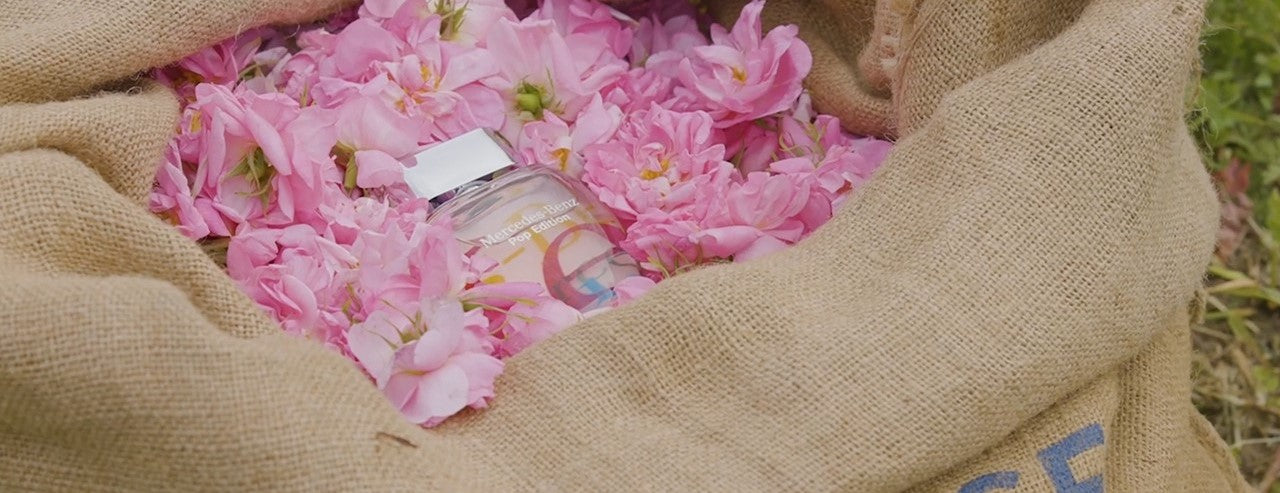

Composition and olfactory pyramid
The world of perfumes is complex and fascinating, with endless possible combinations of ingredients to create unique fragrances. The composition of a perfume is based on the delicate harmony between the different elements that constitute it: top notes, heart notes and base notes. Discover the secrets of this captivating alchemy and how it brings our favorite fragrances to life.
The olfactory pyramid: three dimensions of a perfume
The olfactory pyramid is a key concept in the development of a perfume, because it structures the different stages of its evolution. Each part of the pyramid corresponds to a family of ingredients giving the perfume its unique olfactory signature.

Top notes: the first impression
Top notes are the first scents perceived when applying a perfume. They are often composed of fresh and light ingredients, such as citrus fruits or certain aromatic plants. These ephemeral smells only last a few minutes, or even an hour maximum, but they play a crucial role: to seduce quickly and make you want to discover what comes next. For example, for our iconic Mercedes-Benz Man perfume, the top note is pear.

Heart notes: the essence of perfume
The true soul of the perfume, the heart notes determine its main character and remain present for several hours. They emerge slowly after the top notes, thanks to body heat which facilitates their evaporation. Flowers, spices or woody ingredients are often favored to compose these notes, expressing themselves fully in harmony with the other elements of the perfume. If we take our example of the Mercedes-Benz Man perfume, the heart note is geranium.

Base notes: a lasting imprint
Finally, the base notes are those which anchor the perfume on the skin and give it its remarkable persistence. Composed of powerful and tenacious ingredients, such as resins, musks or animal aromas, they can remain perceptible for days. They are the ones who complete the olfactory work and allow the perfume to mark memories. For example, for our Mercedes-Benz Man perfume, the base note is rosewood.
The different types of olfactory pyramids
Depending on the recipe and the complexity of a composition, a fragrance can present several olfactory structures. Here are some examples of possible pyramids:

Classic: this is the most common type of olfactory pyramid, in which the top notes are light and volatile, the middle notes are complex and balanced, and the base notes are deep and lingering.
Linear: unlike the classic pyramid, where the notes evolve gradually, a linear pyramid offers a stable structure by maintaining a constant balance of scents throughout evaporation. This gives these fragrances a soft, almost monochrome feel.
Juxtaposition: juxtaposition pyramids feature contrasting pairings that provide a unique sensory experience. For example, floral notes can coexist with woody or gourmand notes to create a true olfactory symphony.
The importance of knowing the olfactory pyramid
Understanding the structure and nuances of a fragrance allows us to better choose the perfume that will correspond to our tastes, our desires and our personality. Indeed, each individual has their own sensitivity to which certain olfactory families will echo while others not.
Additionally, the raw materials used to develop different scent notes may have a different reaction on each skin. A perfume can thus develop particular accentuations depending on its interaction with the pH or temperature of our epidermis.
Finally, understanding the olfactory pyramid helps us better appreciate the evolution of a perfume over time. We can thus be better able to distinguish the different scents and notes exhaled by our favorite fragrance and to identify if it changes in intensity or character after a few hours on our skin.
The main olfactory categories
To make it easier to understand the olfactory pyramids, it is possible to divide ingredients and scents into several large olfactory families. Here are some examples :
- Fresh: fresh scents consist of light notes like citrus, fruits, herbs and some flowers. This is the case of our Mercedes-Benz SEA perfume.
- Floral: floral families bring together fragrances based on flowers, whether alone or mixed together to obtain bouquets of delicate or complex scents. Like our Mercedes-Benz For Women Rose perfume.
- Oriental: oriental perfumes offer a wealth of spicy, amber, woody or gourmand ingredients that evoke sensuality and exoticism. If that's what you're looking for, you'll love our Mercedes-Benz Club Black scent.
- Woody: woody fragrances include a set of notes from cedar, sandalwood, patchouli or resins. They bring depth and mystery to perfumes. Particularly like our Mercedes-Benz LAND perfume.
The essential ingredients in a perfume
Several basic components are essential to the development of a perfume. The choice and quality of these substances largely determine the success of the fragrance.
- Essential oils: they provide the very essence of the perfume and are obtained by distillation or cold extraction of fragrant plants, such as flowers, bark or leaves.
- Alcohol: it is used as a solvent to dissolve essential oils and allow the fragrance to vaporize into fine droplets. Its concentration varies depending on the type of perfume (e.g.: 80% in a perfume, 70% in an eau de toilette).
- The volatile solvent: in addition to alcohol, it stabilizes the composition and promotes the evaporation of olfactory notes.
- Aromatic ingredients: such as absolutes, concretes or synthetic molecules, they add complexity and relief to the perfume.
Distillation: a key process for extracting aromas
One of the fundamental principles of creating a perfume is distillation, which involves separating odorous compounds from plants using water vapor or some more modern techniques. This ancestral method makes it possible to obtain the precious essential oils which will give life to the fragrances.
1. Steam distillation
This traditional technique, dating from the Middle Ages, is based on the use of water vapor to carry away the odorous molecules of plants and separate them from other impurities. The resulting mixture is then cooled to recover the essential oil on the one hand and the scented water, called hydrosol, on the other.
2. Distillation by steam distillation
This more modern method is particularly suitable for fragile or heat-sensitive plants. The water vapor is introduced into a tank containing the chopped plants, and the odorous molecules are entrained and then recovered with the condensation water. The essential oils thus obtained are of better quality because they are not altered by heat.
You are now initiated into the delicate and complex art of composing a perfume. Every step, every ingredient counts to create captivating and unforgettable fragrances. So the next time you breathe in the intoxicating scent of a perfume, think of the olfactory wonders hidden behind these captivating scents.

Olfactory chronicles
by Mercedes-Benz Parfums
To know all the secrets of the world of perfumery,
discover all our articles written by our experts.
